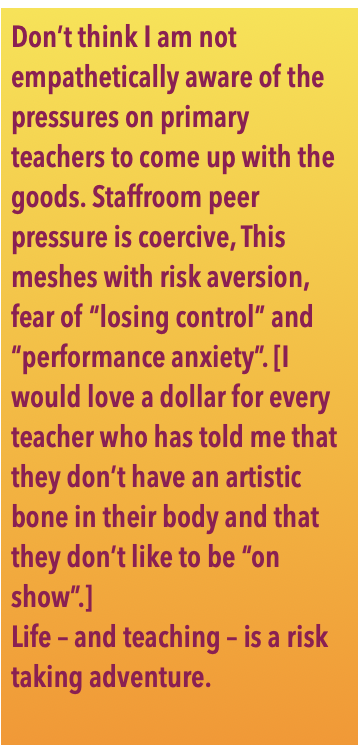Drama Thursday - The Gingerbread Man Visits Year 1
/Thursday is assembly day at D. Primary School. It’s Room A3 Year One students’ turn. As the projected slide announces, they are performing The Gingerbread Man.
The assembled school sing along to the recording of the upbeat Australian National Anthem with the didgeridoo intro. The Student Councillors lead the presentation of honour certificates. There’s a few “dad” jokes from the Deputy Principal, innocent and silly, drawing groans from the assembled audience. The school song (with the odd scansion) is sung conducted by the enthusiastic music teacher. The student and teacher audience members sit in plastic chair rows. Parents edge the covered area shivering a little in the crisp air.
The Year 1 students have been sitting on the stage spread in a regular checkerboard pattern. They have conned their lines. Rehearsed ( William, with rolled eyes, tells us that the only thing they’ve done this week is rehearsed their lines).
Narrators line up to step on the box behind the podium. Other students sit in clumps in costumes improvised by busy mums. The little old couple sit awkwardly next to their cardboard box painted as an oven. Busy Year six students scurry in and out thrusting microphones at the line speakers (sometimes getting the right person). Lines are read or stumbled past. At one point the teacher rushes from her seat in the front row to help one of the narrators turn the A3 size script. The chase of the gingerbread man ambles aimlessly round and round. Then suddenly it’s finished.
There are more certificates.
The Year Ones thank the audience and sends them back to class.
Parents rush the stage as the photos are taken.
Like a released spring the Year Ones cavort and run free on the stage. There’s a frenzy of relief and exuberance.
The drama teacher in me wonders: is this as good as it gets!
There’s an obvious mismatch of expectations. Here the hope is performance. The way the audience are ranged, the structuring, the reliance on script (tired, cliched, word driven), set up a performance paradigm. The drama experience is narrowed and limited. Controlled.
How could it be different?
Let’s begin by saying to the assembled audience: today we are not performing a play to you; we are sharing our drama making experience.
Then: teacher in role of leader begins a moved visualisation with all the children (edging into the drama experience): Once there was a time when we were making gingerbread. Can you smell the things we need to make the gingerbread. Can you feel the flour in our fingers? Can you smell the ginger…? Let’s put these ingredients into a big bowl and stir the all up
Placing two chairs: In this telling of the story there was an old man and an old woman. Can you imagine them, sitting in their chairs. They were very very old but still loved life. Who would like to be in these roles? Invite two children to become the roles. Add a couple of simple props to indicate the roles: a hat and a scarf.
How do you think they might sit? How might they move? How could we show that they are very very old?
They loved gingerbread. Do you like gingerbread? What does it taste like?
What do you think they might say about their gingerbread?
And so on through the emergence of the gingerbread man from the oven; the bolshie challenge to authority; the escape; the fox and the river. Use simple storage is such as still image/tableau. When it comes to the chase, use slow motion. Map the chase specifically. Create and add new roles. Engage students in drama making.
In other words, shift the whole paradigm.
Of course, it’s risky.
Of course, it doesn’t have the element of control. Things may happen that you don’t anticipate.
But, ask important questions
Who is the drama for at this age?
What is the relevant learning?
How do we make this age appropriate and developmentally appropriate learning?
There are a couple of questions to answer.
What will the assembly audience see!
They will see and hear process rather than product. Or a different kind of product. And that needs explaining/preparing.
Isn’t this putting the teacher more important than the students. It’s not about me. It’s all about the kids!
That question underlines the issue of understanding the role of the teacher as the co-constructor of meaning in learning.
I hear the protests: this isn’t much of an assembly item for the rest of the school!
How do we know if it hasn’t been tried? How do we school the school about doing things differently. There is a time and a place for the “performance of drama”. But there is also a place for celebrating the immediacy and joy of the drama experience itself. And that is what truly matters most.
Was it a good experience for the students?
What did they learn?






